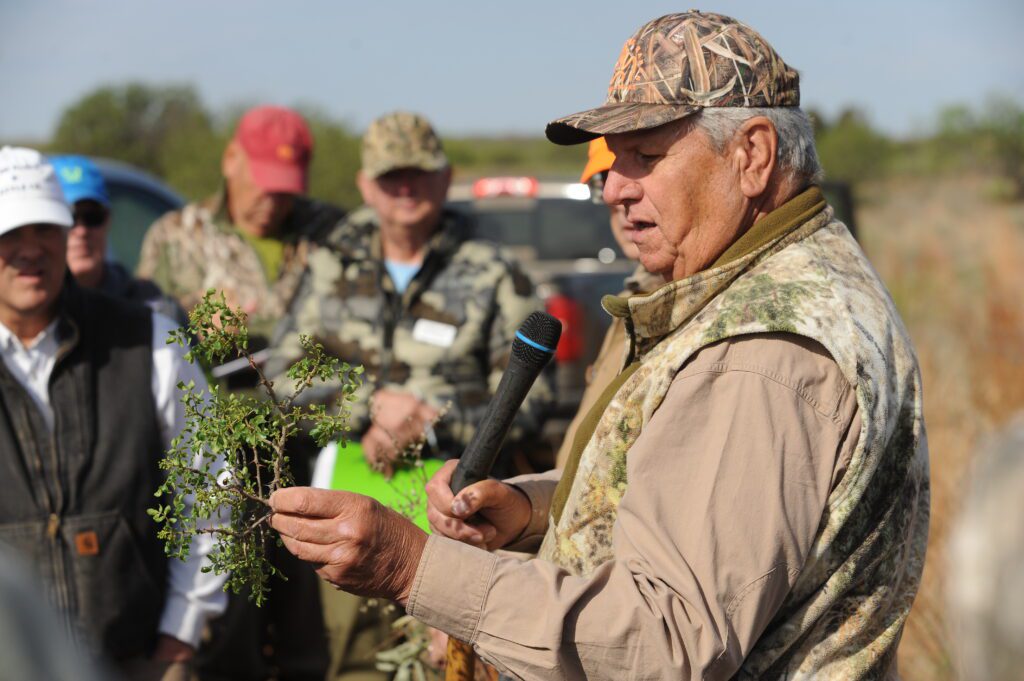QuailMasters brings in diverse group
It’s like the Bobwhite Brigades, an intensive 5-day quail and leadership camp for younger students — except this is for adults. At the QuailMasters class, brought back after a hiatus since 2018, about 40 participants came in from five states and Mexico to learn about quail and quail habitat management.
Before heading to the ranches, the group slept in their Abilene hotel rooms, hearing the first downpour in recent memory, thinking it could be a good sign. And the next morning after heading an hour north, they heard the ranchers say they couldn’t remember the last time it rained.
Led by quail guru Dr. Dale Rollins, the 2-day course held April 25-26 included a tour of three different Stonewall County ranches. Two of the participants from the Rio Grande Valley wanted to learn about quail and managing the land they had inherited. One man, from Houston, had leases near Hebbronville. The youngest? A third grader from Fredericksburg there with his dad, thinking he was getting out of school, but spending part of the time in a class- room learning about quail and quail habitat.
“Do you have quail there?” someone asked his dad.
“Surprisingly, we do,” the dad replied.
The group was diversified, especially when it came to footwear. Some donned hiking boots or tennis shoes. Others wore snake boots, and a few wore chaps. Some of the boots were obviously brand new, while others were well broken in.
At the first stop, Rollins and volunteers immediately started picking up plants. The classroom activity included a good bit of plant identification, and how to use the new apps to identify a plant by a photo. Sand and soil types were examined, and which types are best for quail were discussed.
Quail calling devices were brought out for a simulated call count, each for 15 min- utes, after which notes were compared on whistles heard.
What was the number one item the quail students learned?
While many activities can help quail, the top factor in quail populations is rain.
Rick Snipes, of the Snipes Ranch, told the group how he started managing for quail 25 years ago, and talked of the con- sequences that exists with everything you do.
Snipes ran 7 miles of water lines to water with small troughs.
“It brought in pigs and varmints that eat quail eggs,” he said. “Then we did sprinklers, but we couldn’t put enough water on it to keep anything wet.”
Quail are known to survive without water sources, getting their water from vegetation and seeds. But other managers feel water helps in extreme conditions, preferring to use troughs and letting the water spill over the edge, wetting the ground below.
“There is a cause and effect to everything you do,” Snipes said. “You have to be diversified.”
Supplemental feed was a topic of discussion, along with how to apply it for the best results.
“If you have good habitat, you have plenty of food,” Snipes said. “It’s a positive step, but it’s not going to change things by itself.”
The rancher across the highway said he spends about $4,000 in feed each year, and believed it helped during the snowstorm and big freeze in the past few years, although songbirds tend to a good percent- age of it.

Piling brush used to be a frequently used quail management technique.
“They collect coons and skunks, so burn them,” Snipes said.
What about disking to spur the new growth of forbs?
A good practice, but it spurs another plant as well: sand burrs.
Everyone who has stepped on them has felt the sting. But what do sand burrs do best?
“They slow down your bird dogs,” Rollins said.
You can even buy seeds for weeds you don’t have, the group learned after talking about plants preferred by quail.
The goals of the attendees varied as well. Some wanted to be able to see their dogs run, while others used GPS on their dogs and didn’t care. Some wanted to manage specifically for quail, while others wanted to manage for deer and other wildlife.
Good habitat is good habitat, they learned. But for quail, there are a few things to look for, Rollins explained, using a softball to illustrate the SHET (Softball Habitat Evaluation Techique).
“You pitch a softball 46 feet,” he said after tossing the ball. “You want it to roll on impact, not stick to have good quail habitat. And you want to be able to pitch it from one spot of good cover to the next — like the locations of the 10 positions on a softball field.”
During the lunch break, sausage links were cooked, and a tortilla served as each person’s plate, napkin and bread.
“This is the best way to feed 45 people,” a member of the group said.
The next stop for QuailMasters, hosted by the Rolling Plains Quail Research Ranch and Texas Wildlife Association, is in South Texas June 5-7 in Hebbronville. Two more will take place in Pampa and at the RPQRR in Roby.
After the day of ranch tours, the windburned crowd returned to Abilene for dinner, now official students of quail.
Unfortunately, they learned there is the one and only thing that cannot be controlled.
Rainfall.
“It’s like 2011 all over again out here,” Rollins said.

